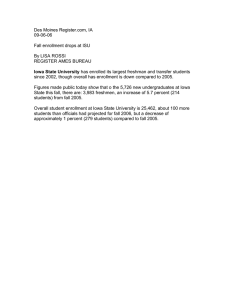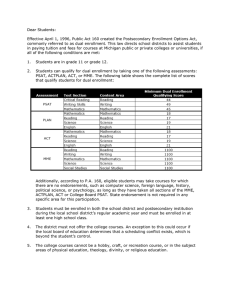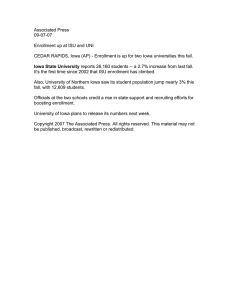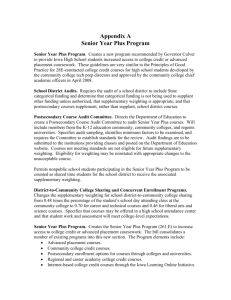DATE: September 25, 2008 TO:
advertisement
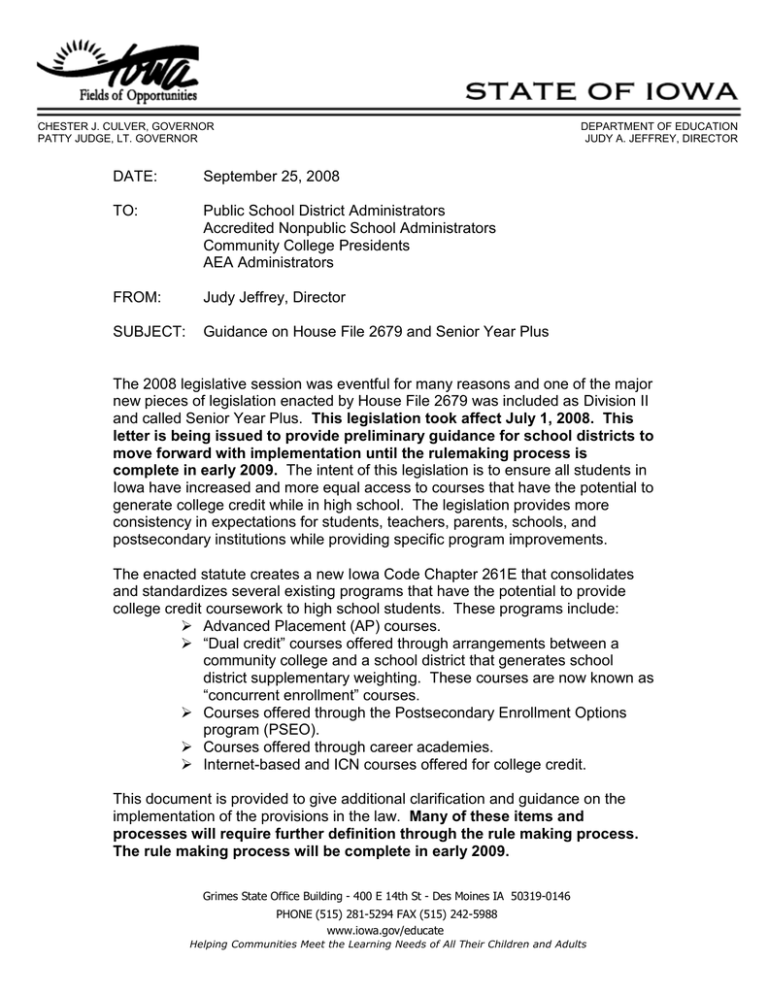
CHESTER J. CULVER, GOVERNOR PATTY JUDGE, LT. GOVERNOR DEPARTMENT OF EDUCATION JUDY A. JEFFREY, DIRECTOR DATE: September 25, 2008 TO: Public School District Administrators Accredited Nonpublic School Administrators Community College Presidents AEA Administrators FROM: Judy Jeffrey, Director SUBJECT: Guidance on House File 2679 and Senior Year Plus The 2008 legislative session was eventful for many reasons and one of the major new pieces of legislation enacted by House File 2679 was included as Division II and called Senior Year Plus. This legislation took affect July 1, 2008. This letter is being issued to provide preliminary guidance for school districts to move forward with implementation until the rulemaking process is complete in early 2009. The intent of this legislation is to ensure all students in Iowa have increased and more equal access to courses that have the potential to generate college credit while in high school. The legislation provides more consistency in expectations for students, teachers, parents, schools, and postsecondary institutions while providing specific program improvements. The enacted statute creates a new Iowa Code Chapter 261E that consolidates and standardizes several existing programs that have the potential to provide college credit coursework to high school students. These programs include: Advanced Placement (AP) courses. “Dual credit” courses offered through arrangements between a community college and a school district that generates school district supplementary weighting. These courses are now known as “concurrent enrollment” courses. Courses offered through the Postsecondary Enrollment Options program (PSEO). Courses offered through career academies. Internet-based and ICN courses offered for college credit. This document is provided to give additional clarification and guidance on the implementation of the provisions in the law. Many of these items and processes will require further definition through the rule making process. The rule making process will be complete in early 2009. Grimes State Office Building - 400 E 14th St - Des Moines IA 50319-0146 PHONE (515) 281-5294 FAX (515) 242-5988 www.iowa.gov/educate Helping Communities Meet the Learning Needs of All Their Children and Adults Page 2 9/24/08 New Definitions The statute includes a few new terms and definitions. Most prominent is the codification of the term “concurrent enrollment” as the label for courses offered by community colleges during the regular school year to school districts under contractual agreements and generating both college and high school credit. These courses were commonly referred to as “dual credit” or “dual enrollment” courses. Another change is use of the terms “institution” and “eligible postsecondary institutions.” Portions of this statute were blended together from preexisting statute for specific program areas. As a result, what may appear to be similar terminology may have different meanings in different places in the law. In this case, an “institution” is any postsecondary or K-12 governance body, while “eligible postsecondary institution” only refers to the Board of Regents institutions, private colleges and community colleges.” A similar approach was used in the definition of “student.” Prior statute related to PSEO allowed students from the Board of Regents’ School for the Deaf and the Iowa Braille and Sight Saving School to participate in PSEO programming. These students may still participate in PSEO and AP programs, but are excluded from concurrent enrollment and career academy coursework. Students served under Competent Private Instruction (CPI) or by an accredited nonpublic school will access the programming as they have previously done so: CPI students through their resident district and students at accredited nonpublic schools through the district in which their nonpublic school is located. Eligibility Criteria Participation criteria are established for students, teachers/instructors, and institutions participating in or delivering any of the programs included under this new chapter of law. Since these are generally high school students, school districts are responsible to ensure compliance with these expectations; however, there are some exceptions. Student Eligibility Criteria Students are expected to understand these criteria prior to participation in any of the programs offered under this chapter. 1. Students must meet any enrollment requirements established by a postsecondary institution providing coursework under this chapter. 2. Students must meet or exceed the minimum performance measures on any academic assessment required by the postsecondary institution. 3. Students must take the prerequisites, if any, established by the school district or postsecondary institution. Page 3 9/24/08 4. Students must have attained the approval of the local school district board or its designee AND the postsecondary institution in order to register for a course at the postsecondary level. 5. The student must be “proficient” in reading, math, and science as evidenced by the last administration of the ITBS/ITED (state assessment). If a student is not proficient in one or more of these content areas, the local board may establish “alternative but equivalent” qualifying performance measures to meet this expectation. These measures could include, but are not limited to, additional administrations of the state assessment, assessments provided by the postsecondary institution (an assessment cut score should be provided by the postsecondary institution to determine proficiency), portfolios of student work, student performance rubrics, or end-of-course assessments. The determination of what is permissible in terms of alternate assessments and equivalent performance lies with the local school district. Teacher and Instructor Eligibility Criteria Teachers (school district) and instructors (postsecondary institution) are expected to know and comply with the following expectations. The institutions employing these teachers and instructors are expected to ensure relevant information is provided to those teachers and instructors so they may comply. 1. The teacher or instructor shall be properly licensed to deliver appropriate programming for the employing institution. For AP teachers, this means an appropriate license through the Board of Educational Examiners (BOEE). For concurrent enrollment or PSEO courses, this means meeting the expectations of the postsecondary institution. 2. If the teacher or instructor is delivering coursework at a school district facility or neutral sight (defined as a facility that is not owned or operated by an institution covered by this chapter), the teacher or instructor must have passed a background check conducted under the definitions included in Iowa Code 272.2(17) [BOEE background check]. Current teachers employed by a school district and licensed by the BOEE are exempt from this requirement. Individuals under suspension or revocation of an educational license or statement of professional recognition by the BOEE shall not provide instruction for any programming under this chapter. The institution of employment is responsible for ensuring this is true and it applies to all programming under this chapter. 3. The teacher or instructor will collaborate, as appropriate, with other secondary or postsecondary faculty in the subject area of instruction. 4. The school district, in collaboration with the teacher or instructor, shall provide ongoing communication to the student and, in the case of a minor student, the student’s parent(s) or legal guardian(s). This communication shall include, but not be limited to course expectations; a syllabus that Page 4 9/24/08 5. 6. 7. 8. 9. describes the content, teaching strategies, performance measures, and resource materials used in the course; and academic progress. The curriculum and instruction provided shall be college-level work as determined by the institution. Valid and reliable student assessment measures will be used to the extent they are available. The teacher or instructor will be provided appropriate orientation and training in secondary and postsecondary professional development related to curriculum pedagogy, assessment, policy implementation, technology, and discipline issues. The teacher or instructor will be provided ongoing communication and access to instructional resources and support and shall be encouraged to participate in the postsecondary institution’s academic departmental activities. The teacher or instructor will be given adequate notification of an assignment to teach a course covered by this chapter and will be given adequate preparation time to ensure the course is taught at a collegelevel. Institutional Eligibility Criteria While school districts are primarily responsible for ensuring courses provided under this chapter meet expectations, postsecondary institutions must also ensure coursework available to secondary students meets certain expectations and the programming meets criteria included in the chapter. In these cases, “institution” is any postsecondary or K-12 governance body. 1. The institution will ensure that students [and in the case of minor students, the parent(s) or legal guardian(s)] receive appropriate course orientation and information, including, but not limited to a summary of applicable polices and procedures, the establishment of a permanent transcript, policies on dropping courses, a student handbook, information describing student responsibilities, and institutional procedures for academic credit transfer. 2. The institution will ensure that students have access to student support services including tutoring, counseling, advising, library, writing and math labs, computer labs, and student activities (excluding postsecondary intercollegiate athletics). 3. The institution will ensure that interested students are properly enrolled in courses in this chapter, assuming the student has met eligibility criteria. 4. The institution will ensure that students and teachers receive appropriate orientation and information about the institution’s expectations. 5. The institution will ensure that any courses provided under this chapter achieve the same learning outcomes as similar courses offered in the subject area and are accepted as college-level work. Page 5 9/24/08 6. The institution will review any course offered under this chapter on a regular basis for continuous improvement, will follow-up with students in order to use information gained from students to improve the course delivery and content, and will share data on course progress and outcomes with any collaborative partners and the Department. 7. The school districts will annually certify to the Department that the courses provided to high school students under this chapter supplement and do not supplant the offer and teach requirements in Iowa Code 256.11. 8. Institutions cannot require a minimum or maximum number of postsecondary credits to be earned by a high school student under this chapter. Postsecondary institutions cannot count a student as a full-time (12 or more semester hours) college student as long as the student is enrolled in high school, regardless of how many semester hours the student is taking. 9. All institutions providing programming under this chapter shall include the secondary school unique student identifier assigned students while in the K-12 system in the institution’s student data management system. Eligible institutions under this chapter shall cooperate with the Department on data requests related to this programming. 10. The school district will ensure that the background checks required of teachers/instructors delivering programming under this chapter were completed by the employing institution. Current teachers employed by a school district and licensed by the BOEE are exempt from this requirement. The school district may charge the teachers and instructors a fee to cover the expense of the background check (no more than actual cost). Questions and Answers on criteria sections Question 1: Is the requirement that students be proficient a disincentive for some students to access certain types of programs, thereby creating an access barrier (e.g., art, home construction, psychology, etc)? The proficiency requirement raises expectations for students, parents, and school districts without creating an access barrier. These students are still in the secondary system and that system needs to do what it can to ensure students have proper preparation for postsecondary-level work. The three academic areas measured by this proficiency requirement are baseline skill areas that cut across all college-level content, so it is a reasonable expectation for students wanting to pursue college credit, particularly given the added opportunity of local school boards to establish alternative criteria. Question 2: Can an individual that is under a suspension or revocation of an educational license or statement of professional recognition issued by the BOEE teach any courses in any of these programs Page 6 9/24/08 (Concurrent Enrollment, AP, PSEO, and Career Academy)? Who will ensure this? No. The school district, in collaboration with the institution providing the coursework, is responsible for ensuring this provision is met. This provision applies to Board of Regents’ institutions and private four-year colleges as well as community colleges and school districts. Specific Program Requirements Advanced Placement Program No statutory language existed prior to this legislation specific to the AP program. This programming can be made available to students outside of the regular school year. The following requirements now apply: 1. School districts will make advanced placement coursework available to all students either through direct on-site instruction, through collaboration with other school districts, or by accessing the online course through a provider. 2. School districts will include descriptions of the AP courses available to students in the secondary course registration handbook. 3. School districts will ensure that AP teachers are appropriately licensed by the BOEE. 4. School districts will establish prerequisites for each AP course offered and will describe these prerequisites in the secondary course registration handbook. This information will be provided to every junior high school or middle school student and their parents prior to the development of the core curriculum plan required pursuant to Iowa Code Section 279.61. 5. AP test fee reimbursement funding, available through the Department, can be requested to cover the fees for students qualifying for reduced fee exams, but districts must use the process that has been in place for several years to get reimbursement for those reduced fee exams. Accordingly, the district can: 1) cover the cost of these reduced fee exams and apply for reimbursement for these fees using the same process as in previous years, 2) simply absorb the cost of these exam fees for these students, or 3) may charge these students $35 total for students qualifying for reduced exam fees per AP criteria ($27 half reduced-fee exam fee + $8 the district retains). 6. The legislature provided funding to defray a portion of each AP exam fee for students statewide. Under this new provision, schools will collect half of the exam fee, plus the portion of the total fee schools typically retained to defray expense. The state will then cover the other half of the exam fee. Educational Testing Services will bill the Department directly for half of the exam fees. Accordingly, for the 2008-09 school year, school districts will charge $46 ($38 half exam fee + $8 the district retains) to Page 7 9/24/08 students not qualifying for reduced exam fees, Postsecondary Enrollment Opportunities Act The majority of the language in the statute related to the PSEO program was moved from Iowa Code Chapter 261C into 261E. Iowa Code Chapter 261C no longer exists. This programming can be made available to students outside of the regular school year. Some adjustments to the preexisting language occurred, so the following points should be emphasized related to this programming 1. This programming is available to all students in grades 11 and 12. Students in grades 9 or 10 are eligible if they are a part of the district’s gifted and talented program. 2. School districts will include descriptions of this program in the secondary course registration handbook. This information will be provided to every junior high school or middle school student and their parents prior to the development of the core curriculum plan required pursuant to Iowa Code Section 279.61. School districts are encouraged to develop procedures by which students indicate interest in and apply for enrollment in this program. 3. Students may only access courses in this program that are not comparable to those offered by the school district. 4. Students accessing coursework under this program in the summer will pay for the cost of that programming and will be limited to a maximum of seven credit hours from the postsecondary institution per summer session. 5. Postsecondary institutions cannot charge students in the program for tuition, textbooks, materials, or fees related to the course unless the students are required to purchase equipment that becomes the property of the student. The new statute emphasizes that textbooks cannot be considered equipment. 6. The Department will maintain a separate guidance document related to PSEO programming. If an issue related to PSEO is not addressed here, interested parties should review the separate PSEO guidance document on the Department’s website at www.iowa.gov/educate/content/view/488/534. 7. Students served under CPI or by an accredited nonpublic school will access the programming as they have previously done so: CPI students through their resident district and students at accredited nonpublic schools through the district in which their nonpublic school is located. 8. PSEO courses that are taken during winter break and in May are eligible for reimbursement. The district must cover the cost up to $250 per student. 9. Students may take up to seven hours of PSEO coursework in the summer, but the district does not pay for the coursework. Page 8 9/24/08 Concurrent Enrollment PIease note: Districts cannot charge students for concurrent enrollment courses. Informally called “dual credit” or “dual enrollment” courses, the statute codified the term “concurrent enrollment” to describe an arrangement by which a community college course is delivered to high school students during the regular school year for both high school and college credit. Concurrent enrollment is now a term that applies specifically to courses that use this arrangement AND that generate school district supplementary weighting. Concurrent enrollment courses may not be offered to students outside of the regular school year. Additional items of note: 1. School districts will include descriptions of this program in the secondary course registration handbook, if made available by the district. This information will be provided to every junior high school or middle school student and their parents prior to the development of the core curriculum plan required pursuant to Iowa Code Section 279.61. School districts are encouraged to develop procedures by which students indicate interest in and apply for enrollment in this program. 2. Courses offered under this program must be college-level work, nonsectarian, cannot supplant local school district “offer and teach” requirements, and must not be substantially the same content course as the one being offered by the K-12 district in the previous two years. 3. Courses offered under this program are available to all students in grades 9-12, if eligible. 4. Students served under CPI or by an accredited nonpublic school will access the programming as they have previously done so: CPI students through their resident district and students at accredited nonpublic schools through the district in which their nonpublic school is located. 5. The funding provisions for concurrent enrollment courses still apply and are found in Iowa Code Chapter 257.11(3). 6. Additional detailed processes for accepting students into these courses are included in the statute, but are already referenced in this guidance in other sections. 7. The Department will maintain a separate guidance document related to concurrent enrollment programming in the instructions for certified enrollment. Changes to existing statute on Concurrent Enrollment House File 2679 made some changes to existing statute as well: 1. Effective for the student count in the fall of 2008 and the funding provided districts in 2009-10, the weightings for concurrent enrollment courses have changed. Courses that are considered career and technical will generate 0.70 additional supplementary weighting and courses that are considered Page 9 9/24/08 liberal arts and science courses will generate 0.46 additional supplementary weighting. 2. Concurrent enrollment courses supplement, but cannot supplant high school courses offered pursuant to Iowa Code Section 256.11(5) – high school offer and teach requirements. 3. Concurrent enrollment courses must be taught in a manner as to result in student work and student assessment which meet college-level expectations. 4. Concurrent enrollment courses can be taught by an instructor employed or contracted by a community college. Other programs that can generate college credit Career Academies Career academies exist to promote training in specific targeted job categories. The permissible areas of support by career academies can be found in Iowa Code 260C.18A(2)(c). Career academy courses may qualify for concurrent enrollment supplementary weighting if those courses meet the provisions of this chapter (Iowa Code 261E.7). School districts sending students to career academy courses offered by other districts may be eligible for supplementary weighting under Iowa Code 257.11(2). Information on career academies must be included in the secondary course registration handbook and provided to students and parents prior to the development of students’ core curriculum plans. Students served under CPI or by an accredited nonpublic school will access the programming as they have previously done so: CPI students through their resident district and students at accredited nonpublic schools through the district in which their nonpublic school is located. Internet-based and ICN courses If the ICN is used to deliver courses to students from other school districts, the course qualifies for ICN supplementary weighting under the provisions of Iowa Code 257.11(7). If an ICN or Internet-based course is used to deliver programming to students, it may qualify for concurrent enrollment supplementary weighting, regional academy supplementary weighting, or district-to-district supplementary weighting if it meets the appropriate provisions of those sections of statute. Even though a course may be eligible for any of the previous supplementary weightings, it may only be counted for one type of weighting. Other programs under this statute that do not generate college credit Regional Academies Regional academies are not technically in the same category as the other programs included in this statute because they do not generate college credit. Page 10 9/24/08 Regional academy courses are district-to-district sharing courses delivered through direct instruction and could include the ICN or Internet-based courses. These courses do qualify for district-to-district sharing supplementary weighting as defined in Iowa Code Section 257.11(2). Information related to any regional academy courses shall be included in the secondary registration handbook and will be made available to students and parents prior to the development of students’ core curriculum plans. Any regional academy must include advanced level courses and may include career/technical education courses, ICN and Internet-based courses. HF 2679 also enacted a new provision to provide a “host” incentive to districts interested in providing Regional Academy coursework. The statute reads: Section 257.11, subsection 2, Code Supplement 2007, is amended by adding the following new paragraph: NEW PARAGRAPH. d. A school district which hosts a regional academy shall be eligible to assign its resident students attending classes at the academy a weighting of one-tenth of the percentage of the student's school day during which the student attends classes at the regional academy. The maximum amount of additional weighting for which a school district hosting a regional academy shall be eligible is an amount corresponding to thirty additional students. The minimum amount of additional weighting for which a school district establishing a regional academy shall be eligible is an amount corresponding to fifteen additional students if the academy provides both advanced-level courses and career and technical courses. Additional guidance on this is forthcoming from the School Finance Team. Questions on this provision may be addressed to Su McCurdy at su.mccurdy@iowa.gov or 515-281-4738. Senior Year Plus Coursework and the Iowa Core Curriculum An amendment to Senate File 2700 added a provision to the overall Senior Year Plus statute. It compels school districts to ensure that any external course being accessed by school district students meets expectations created by the mandated Iowa Core Curriculum. The Department will work with AEAs and school districts on the best way to align the essential concepts and skills in the implementation guidelines that are being developed. Section 257.11, Code Supplement 2007, is amended by adding the following new subsection: NEW SUBSECTION. 8A. A school district shall ensure that any course made available to a student through any sharing agreement between the Page 11 9/24/08 school district and a community college or any other entity providing course programming pursuant to this section to students enrolled in the school district meets the expectations contained in the core curriculum adopted pursuant to section 256.7, subsection 26. The school district shall ensure that any course that has the capacity to generate college credit shall be equivalent to college-level work. Monitoring and Accountability School Audits Provisions in the Senior Year Plus statute adjust procedures for school audits to include a review of categorical or designated funding streams. All supplementary weightings included in Iowa Code Section 257.11 are now with the purview of the audit process. State auditors have been instructed that school audits will include, at a minimum, “a determination that the laws of the state are being followed, that categorical funding is not used to supplant other funding except as otherwise provided, that supplementary weighting is pursuant to an eligible sharing condition, and that postsecondary courses provided in accordance with Section 257.11 and Chapter 261E (Senior Year Plus) supplement rather than supplant, school district courses.” Postsecondary Course Audit Committee The Department is charged with the establishment and facilitation of a postsecondary course audit committee that will annually audit postsecondary courses offered to high school students in accordance with Iowa Code Chapter 261E (Senior Year Plus). These audits will be random and a sampling of the total courses available statewide. Standards for review must be developed for this process in rule. Findings of these audits will be provided to the institutions involved and posted to the Department’s website. If a course is found to be in violation of the statute and rule, it will not be eligible for future supplementary weighting, but the institutions have the ability to make appropriate adjustments in the course and resubmit the course for approval by the audit committee. Summary The Department will continue to move forward with various stakeholders on the rules development process and implementation of the statute. Additional guidance and information will be distributed when it is available. For any additional questions, please contact Kevin Fangman at 515-281-3333 or kevin.fangman@iowa.gov.
